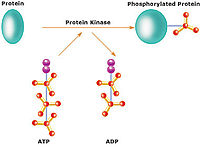
Nutrient Sensing by Histone Marks: Reading the Metabolic Histone Code Using Tracing, Omics, and Modeling
Sign Up to like & getrecommendations! Published in 2020 at "BioEssays"
DOI: 10.1002/bies.202000083
Abstract: Several metabolites serve as substrates for histone modifications and communicate changes in the metabolic environment to the epigenome. Technologies such as metabolomics and proteomics have allowed us to reconstruct the interactions between metabolic pathways and… read more here.
Keywords: sensing histone; reading metabolic; histone marks; marks reading ... See more keywords

Nutrient sensing pathway genes expression dysregulated in patients with T2DM and coronary artery disease.
Sign Up to like & getrecommendations! Published in 2019 at "Diabetes research and clinical practice"
DOI: 10.1016/j.diabres.2019.03.036
Abstract: AIMS Type 2 diabetes mellitus (T2DM) is a chronic metabolic disorder and its prevalence is rapidly increasing worldwide. Patients with T2DM suffer from an increased risk of vascular complications. Of these, the development of coronary… read more here.
Keywords: cad t2dm; nutrient sensing; expression; patients t2dm ... See more keywords

Peripheral and Central Nutrient Sensing Underlying Appetite Regulation
Sign Up to like & getrecommendations! Published in 2018 at "Trends in Neurosciences"
DOI: 10.1016/j.tins.2018.05.003
Abstract: The precise regulation of fluid and energy homeostasis is essential for survival. It is well appreciated that ingestive behaviors are tightly regulated by both peripheral sensory inputs and central appetite signals. With recent neurogenetic technologies,… read more here.
Keywords: central nutrient; underlying appetite; sensing underlying; peripheral central ... See more keywords

Nutrient sensing, taste and feed intake in avian species
Sign Up to like & getrecommendations! Published in 2018 at "Nutrition Research Reviews"
DOI: 10.1017/s0954422418000100
Abstract: Abstract The anatomical structure and function of beaks, bills and tongue together with the mechanics of deglutition in birds have contributed to the development of a taste system denuded of macrostructures visible to the human… read more here.
Keywords: taste; system; feed intake; avian taste ... See more keywords

Nutrient sensing modulates malaria parasite virulence
Sign Up to like & getrecommendations! Published in 2017 at "Nature"
DOI: 10.1038/nature23009
Abstract: The lifestyle of intracellular pathogens, such as malaria parasites, is intimately connected to that of their host, primarily for nutrient supply. Nutrients act not only as primary sources of energy but also as regulators of… read more here.
Keywords: malaria parasite; virulence; sensing modulates; modulates malaria ... See more keywords

Associations between the activity of placental nutrient-sensing pathways and neonatal and postnatal metabolic health: the ECHO Healthy Start cohort
Sign Up to like & getrecommendations! Published in 2020 at "International Journal of Obesity"
DOI: 10.1038/s41366-020-0574-y
Abstract: Objective Our hypothesis was that the activity of placental nutrient-sensing pathways is associated with adiposity and metabolic health in childhood. Research design and methods Using placental villus samples from healthy mothers from the Healthy Start… read more here.
Keywords: placental nutrient; sensing pathways; metabolic health; activity placental ... See more keywords

The metabolic impact of small intestinal nutrient sensing
Sign Up to like & getrecommendations! Published in 2021 at "Nature Communications"
DOI: 10.1038/s41467-021-21235-y
Abstract: The gastrointestinal tract maintains energy and glucose homeostasis, in part through nutrient-sensing and subsequent signaling to the brain and other tissues. In this review, we highlight the role of small intestinal nutrient-sensing in metabolic homeostasis,… read more here.
Keywords: sensing metabolic; small intestinal; intestinal nutrient; impact ... See more keywords

Regulation and repurposing of nutrient sensing and autophagy in innate immunity
Sign Up to like & getrecommendations! Published in 2020 at "Autophagy"
DOI: 10.1080/15548627.2020.1783119
Abstract: ABSTRACT Nutrients not only act as building blocks but also as signaling molecules. Nutrient-availability promotes cell growth and proliferation and suppresses catabolic processes, such as macroautophagy/autophagy. These effects are mediated by checkpoint kinases such as… read more here.
Keywords: repurposing nutrient; kinase; regulation repurposing; receptor ... See more keywords

Metabolomics applied to islet nutrient sensing mechanisms
Sign Up to like & getrecommendations! Published in 2017 at "Diabetes"
DOI: 10.1111/dom.13010
Abstract: After multiple decades of investigation, the precise mechanisms involved in fuel‐stimulated insulin secretion are still being revealed. One avenue for gaining deeper knowledge is to apply emergent tools of “metabolomics,” involving mass spectrometry and nuclear… read more here.
Keywords: applied islet; metabolomics applied; insulin secretion; sensing mechanisms ... See more keywords

Regulated proteolysis of p62/SQSTM1 enables differential control of autophagy and nutrient sensing
Sign Up to like & getrecommendations! Published in 2018 at "Science Signaling"
DOI: 10.1126/scisignal.aat6903
Abstract: A p62 fragment generated by caspase-8 regulates responses to nutrient availability, rather than autophagy. Cleaving a different function for p62 The scaffold protein p62 has a critical role in autophagy, the regulated degradation of proteins… read more here.
Keywords: caspase; p62trm; regulated proteolysis; p62 ... See more keywords

Nutrient Sensing at the Plasma Membrane of Fungal Cells.
Sign Up to like & getrecommendations! Published in 2017 at "Microbiology spectrum"
DOI: 10.1128/microbiolspec.funk-0031-2016
Abstract: To respond to the changing environment, cells must be able to sense external conditions. This is important for many processes including growth, mating, the expression of virulence factors, and several other regulatory effects. Nutrient sensing… read more here.
Keywords: membrane fungal; sensing plasma; fungal cells; membrane ... See more keywords